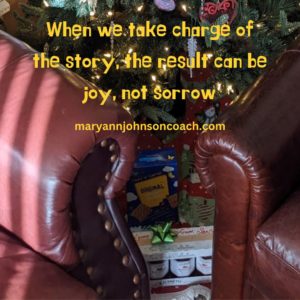 Guess what runs in my family? Depression. For some, it is outright depression and for others, it is seasonal depressive disorder or SAD (seasonal affective disorder). It isn’t just in my family of origin but in my extended family. As a kid, I watched a lot of adults struggle and I have watched siblings, cousins, and some of my children struggle. The bleak days of winter bring an added challenge. In some places, winter lasts a long time!
Guess what runs in my family? Depression. For some, it is outright depression and for others, it is seasonal depressive disorder or SAD (seasonal affective disorder). It isn’t just in my family of origin but in my extended family. As a kid, I watched a lot of adults struggle and I have watched siblings, cousins, and some of my children struggle. The bleak days of winter bring an added challenge. In some places, winter lasts a long time!
Some take medication and some don’t. Regardless, because of this propensity, we all must work at managing stress and learn to care for ourselves.
In February 2022, I spent some time in Seattle at my youngest daughter’s home. One evening we were talking about depression and stress. The reason it came up is that Kate is learning to live a good life with depression. At the time, I was struggling with a hormone disorder and the stress of four years of caregiving had gotten me down.
We shared with each other what we individually do to relieve stress and take care of ourselves; how we treat ourselves with compassion so that we manage better. It was interesting that we had some things in common, but we also had different things on our lists.
This article isn’t about managing stress or overcoming depression. It’s to share some things that have worked for my daughter and me. Whether you have depression or not, if you are parenting then you have stress and some depressing days. It comes with the territory. I thought you might like to see what we do and if you feel so inclined, please respond in the comments below because other moms will be interested in what you can add to these lists.
SO HERE GOES
•The number one thing on my list was sleep. I learned the hard way, over a 30-year period, how vital this one thing is. You can read about my experience HERE.
•Second, I learned the value of taking deep breaths. Taking four deep breaths and then letting them go can help you remain in control when life is going South. This little trick can be done in a traffic jam, when your toddler spills a bag of rice, or when your husband isn’t helping. It does require practice and I am still practicing. : )
•Third, I make time to read. When I was a younger mom, I would stay up till one or two in the morning reading. Of course, you know from point one, that had to stop. I have learned to read in snatches. I keep a basket of books in the bathroom, and I read a few paragraphs each time I go in there. It has been amazing how much I get read in a year, just a few paragraphs at a time.
Because I have no little kids you probably think I would have lots of time to read. Not so. Not even in the bathroom. I live with two adults with bladder issues and four grands whose own bathroom is frequently occupied, and so like you, someone is always knocking on the door. LOL Hence, learning to read in snatches, a few paragraphs at a time.
•Fourth, I have learned to drink water. I have never had a strong sense of thirst and I can become so focused on what I am doing that I will go hours without drinking anything, even during the summer while working outside. I know, crazy. So, I have had to learn to drink water regularly. I know how much I need, and I keep track of what I take in. It makes a huge difference in my attitude and my health.
•Now we come to point five, eat well and regularly. It’s sort of like the water, especially when I had a house full of kids. I would get distracted and forget to eat. That would happen even now if I didn’t have a system for meals. The system is simple – I sit down at the table to eat every meal. It was hard to make myself do this in the beginning. I mean, you can get a lot done while eating a sandwich. LOL But I no longer allow myself to care so little for myself.
•Sixth, give and accept grace and forgiveness. I have learned to forgive myself for not being perfect. For making mistakes. For missing deadlines, appointments, etc. I have learned to give myself grace and to accept the grace of Christ. This one thing has been HUGELY powerful in my life and frankly, has made the most difference.
•Seventh, having an openness to seeing what I need and then responding. I have learned to listen to my body, my heart, and my mind. When I sense a problem in any of those areas, I take time to ponder and I pray to determine what I need to do.
For example, after a disastrous mix-up in my hormone prescription for over half of 2022, I arranged three counseling sessions. The counselor couldn’t reverse the months of suffering from the lack of the correct medication, but she did help me sort out how I felt about it and how I was going to move forward from it. I haven’t done personal counseling before and I never thought I would, but I listened to myself, had a talk with God, and it seemed like the right thing to do. It was!
•Number eight is self-care. I have two very simple self-care rituals. I shower each night. I light a candle and stand under the wonderfully hot water. I say a prayer for someone I know is in need. Then I dry off and lotion my body. I do this almost every night. It calms my soul, helps me think about others, and gives me a chance to breathe and be alone. Being alone is a very hard thing to get when you are parenting or caregiving; and frankly, we all need some alone time!
My Daughters List
•The number one thing on Kate’s list was therapy. She didn’t have the same issues I have had thinking about getting therapy and went for it without feeling broken. It has helped immensely. She needed some guidance as to how to move forward despite her depression and she got it. Don’t be afraid to get counseling, therapy, or mentoring if you are in over your head. It can make a huge difference.
•Number two on Kate’s list was journaling. I was surprised and hadn’t thought of that as self-care. I should have because all those decades ago, when our family was falling apart, I journaled almost every night and it kept me together. There is great value in writing down what is happening in your world and how you are feeling about it.
A little over ten years ago I learned and used another writing activity that was helpful – free writing. When you are angry, sad, depressed, or have wounded or less than feelings, free writing is powerful for healing and forgiving. You sit down alone and write whatever comes to mind. It doesn’t have to be nice, spelled correctly, or what a ‘good girl’ would say. You can let it all spill out. Then you burn it.
You don’t cover another person with your stuff, yet you get it out. Then you set it on fire, and it goes up in smoke. I can attest to how satisfying it feels to see all that ‘stuff’ go up in flames!
•Kate’s, third item was meditation. It hasn’t been on my stress relief list, but it should be. I learned to meditate a little over a decade ago and it is very soothing and helpful. I meditate myself to sleep. No music, just a simple mind practice that works almost 100% of the time. If you, like I did when I began, have negative feelings about meditation or are sure you couldn’t do it, then read the book Eight Minute Meditation by Victor Davich. It was a game-changer for me.
•Fourth on Kate’s list was alone time. I mentioned that I get that in my two self-care rituals. I have never had alone time on my list as its own thing because I don’t make it happen. Kate does. She determines what she needs and then she talks with her husband, and they make it happen together.
This last summer she went on a hiking trip by herself for a week. She camped by a lake and rested her heart, her mind, and her body. I was amazed as that is something I would never have done but she came home a renewed woman.
I have made an effort in the last few years. I have gone to a BnB for three days a couple of times. However, I always break down and call Don and invite him over. The truth is that I allow myself to feel guilty for being by myself. In fact, Don and I were talking about this very thing this week.
I said that a wonderful gift for my birthday, which is coming up, would be to go to a BnB for a few days. I have some writing I would like to do and having no interruptions would be a blessing. At the end of the conversation Don said, “Hmmm, I didn’t hear ‘we’ in there. LOL
Alone time is a great item to have on your stress relief list but keep in mind that you have to make it happen. That is why it isn’t on my list. I have some old habits, that at 73 I am not interested in tackling. We need to be honest about where we are so that we don’t feel like failures or riddled with guilt by putting something on our list that we are not ready to do.
This type of alone time isn’t something I can easily do, so I have different items on my list that work and that I can manage. I do get alone time every day in my shower. : )
•I LOVED the fifth thing on Kate’s list – communication, being willing to ask for help from others. It is a bit like my number seven, listening to your body, heart, and mind. I am very skilled in listening to my body but sometimes you need more.
I am not as practiced in communicating and I freely admit it. Asking for help isn’t something I have done for most of my life and now I have a habit of not asking for help. That is why getting counseling was such a BIG deal.
Lately, I have asked Don for help with things around the house and in caring for my mom. Even more important, I have been willing to accept help when he or my mom offers it. It is a habit to say, “No, I’m good. I can handle it.” Here again, honesty about where we allow ourselves to get stuck is important.
Kate asks for help. She doesn’t consider it a weakness. It is a strength to be able to ask for and accept help from others. I love this item on her list and have decided to add it to my list and work on it more in my own life.
•Her final item, like mine, was self-care. I was impressed by something she said to me. “We have basic needs and then there are the things that ground and rejuvenate us. A lot of women get those mixed up.” She talked about a shower as being a basic need, so by itself, it doesn’t fill the role of self-care. Then she said, “However, mom, when you add a candle and an intentional prayer like you do, then it moves from a basic need to self-care.” She also mentioned shopping alone as a basic need that is often touted as self-care because the mom is alone.
However, as Kate said, if an activity doesn’t ground and rejuvenate you then it isn’t really self-care. If we add sipping your favorite drink and listening to your favorite music to and from the store, well, shopping moves from a basic need to self-care. : )
When considering if she is actually caring for herself, Kate asks this question after an activity – “Do I feel rejuvenated? Did the activity remind me of who I am?”
So, what are some of Kate’s self-care items? You are going to love this list.
–she reads self-help books
–she likes to sit and doodle with a pen and pencil
–she always gets into a perfectly made bed
Let’s dig deeper into the made-bed thing. Kate doesn’t make her bed when she gets up. It doesn’t work for her or her schedule. But when it’s time for bed, she makes it and makes sure it is beautifully done. Then she lights a candle, washes her face, and sits in her beautifully made bed for 10 or 15 minutes before laying down to sleep. She might read one of those self-help books. : ) As she said to me, “Kate is a wife and a mom, but Kate, is also a separate person and I need to do what fills me and grounds me.”
Can you see how Kate moved going to bed from a basic need to self-care? Can you see how I do that with my shower? With a little thought, we can care for ourselves and relieve stress right at home, in very simple ways. We can’t often get away for three days or a week alone by a lake. However, we can find a few things that can be done right where we are and that we can structure so they fill us and ground us.
Hopefully, our lists have been instructional for you, and if you don’t have a clear idea of how to manage the stress and down days in your life, you will work on a list of your own.
When there are a few things you can bring to mind, to do in the moment, it can make all the difference in how you manage your days.
 In the next four weeks, I am going to be sharing articles I wrote over ten years ago. Why? Because they were fun, contained great information and when I reread them, I fell in love with my family all over again. I will have a current introduction to each article, but I‘m not going to adjust the information to make it appear that it is in the now. You will see people and situations as they were over a decade ago.
In the next four weeks, I am going to be sharing articles I wrote over ten years ago. Why? Because they were fun, contained great information and when I reread them, I fell in love with my family all over again. I will have a current introduction to each article, but I‘m not going to adjust the information to make it appear that it is in the now. You will see people and situations as they were over a decade ago.


 When I woke up that bright and sunny morning, I never suspected that I’d burn down my bedroom. But some days just don’t go as planned.
When I woke up that bright and sunny morning, I never suspected that I’d burn down my bedroom. But some days just don’t go as planned.
 Understanding truth changes lives
Understanding truth changes lives
 My granddaughter joined a group called
My granddaughter joined a group called  hamburger bits as small as I wanted them for a particular dish. I grabbed the meat chopper, because it was close, and cut up the partially cooked chunks. Hmmm, that was easy even though the meat was hot and partially cooked. I could have gotten the job done with a spoon, but it would have taken more time.
hamburger bits as small as I wanted them for a particular dish. I grabbed the meat chopper, because it was close, and cut up the partially cooked chunks. Hmmm, that was easy even though the meat was hot and partially cooked. I could have gotten the job done with a spoon, but it would have taken more time.
 In August 2010 I wrote an article that I posted on my original blog, Home School Coach. It was titled
In August 2010 I wrote an article that I posted on my original blog, Home School Coach. It was titled 
 2022 was hard! There was a reason for that, and I was finally brave enough to tell you about it in last week’s article,
2022 was hard! There was a reason for that, and I was finally brave enough to tell you about it in last week’s article, 
 Guess what runs in my family? Depression. For some, it is outright depression and for others, it is seasonal depressive disorder or SAD (seasonal affective disorder). It isn’t just in my family of origin but in my extended family. As a kid, I watched a lot of adults struggle and I have watched siblings, cousins, and some of my children struggle. The bleak days of winter bring an added challenge. In some places, winter lasts a long time!
Guess what runs in my family? Depression. For some, it is outright depression and for others, it is seasonal depressive disorder or SAD (seasonal affective disorder). It isn’t just in my family of origin but in my extended family. As a kid, I watched a lot of adults struggle and I have watched siblings, cousins, and some of my children struggle. The bleak days of winter bring an added challenge. In some places, winter lasts a long time!


